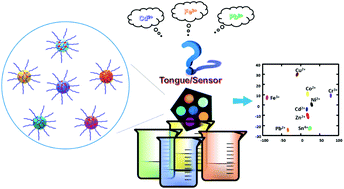Fluorescent electronic tongue based on soluble conjugated polymeric nanoparticles for the discrimination of heavy metal ions in aqueous solution†
Abstract
A fluorescence sensing array (or fluorescent electronic tongue) based on six sorts of soluble conjugated polymeric nanoparticles (SCPNs) decorated with PEG chains is designed for the rapid identification of heavy metal ions in water. The observed fluorescence attenuation originates from the photoinduced electron transfer (PET) between the sensors (donors) and the target analytes (acceptors). An 18-dimensional vector generated by the array is then subjected to linear discriminant analysis (LDA) and hierarchical clustering analysis (HCA) to build a chemical database pool for distinguishing nine analytes (Cr3+, Fe3+, Co2+, Zn2+, Cu2+, Pb2+, Sn4+, Ni2+, Cd2+) at 1 mM level. The prediction tests of “unknown samples” using the array are carried out, reaching 100% accuracy. With good disposability (filter paper as substrates) and high sensitivity (within minutes exposure time), this type of SCPN-based fluorescent electronic tongue enables multiple heavy metal ion detection and water quality analysis with high efficiency and low cost.



 Please wait while we load your content...
Please wait while we load your content...